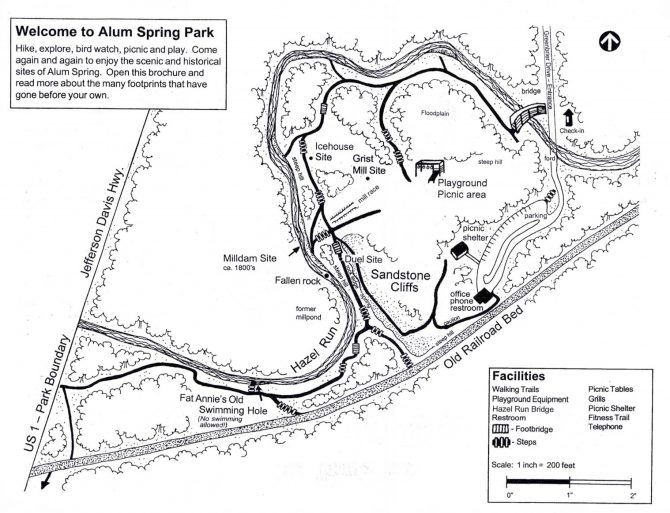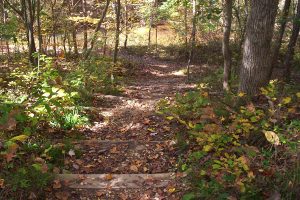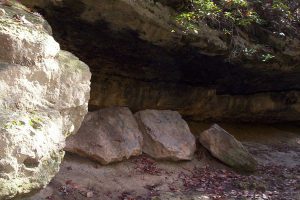By Barbara Crookshanks
Alum Spring Park is a 34-acre woodland retreat off Greenbriar Drive with a playground and hiking trails. Its sandstone cliff, also known as the Alum Spring Rock, is 400 feet long and 40 feet high.
The park also is one of Fredericksburg's most historic sites. Through the centuries those who came before us, the remembered and the forgotten, were here. All played their roles in area history.
The year George Washington was born, Colonel William Byrd of Westover visited Fredericksburg and wrote in his A Progress to the Mines in the Year 1732: "Two miles from this place [18th-century Fredericksburg] is a spring strongly impregnated with alum and so is the earth around it. This water does wonders for those who are afflicted with dropsy."
The Alum Spring that Byrd wrote of is at the far end of the sandstone cliff. In his day, the water flow was much greater than at present. Water seeping from under the cliff, midway along the path, deposits a crystalline layer of pink, white or yellow alum on the ground.
Alum is any of a group of hydrated double salts, usually consisting of aluminum sulfate, water of hydration, and the sulfate of another metal. Today the various alums have many uses including the production of medicines, textiles, sugar, paper, paints, matches, deodorants, baking powder, and for water purification and waterproofing paper. The styptic pencil, a short medicated stick applied to a cut to stop bleeding, is often made of alum.
In the past, alum was used for preserving meats and tanning hides. It is still a key ingredient in vintage pickle recipes.
Many believed that alum spring water had curative powers, and they flocked to such Virginia springs as Rockbridge Alum and Bath Alum. In 1895, John H. Buis, then a part owner of the Alum Spring tract, tried to spark interest in turning the Fredericksburg spring into a health resort.
He extolled the properties of the water in a letter to The Free Lance newspaper saying that he "well nigh despaired of ever enjoying health again" until he received 10 gallons of Alum Spring water from a friend.
Nothing came of his idea.
The Alum Spring sandstone cliff is a geological formation about 100 million years old. During the days of dinosaurs, waters flowing from the western mountains toward the newly- formed Atlantic Ocean carried tons and tons of sediment which formed present-day sandstone.
George Washington surveyed the Alum Spring property for his brother-in-law, Fielding Lewis of Kenmore. Lewis was the first of several to operate a mill at Alum Spring, and his son John would become the next owner.
Buildings at Alum Spring were used as a prison housing Hessian and British troops captured at Trenton, New Jersey, by George Washington. After the surrender of Cornwallis, the buildings were also used as a hospital. Dr. Charles Mortimer, first mayor of Fredericksburg and physician to George Washington's mother Mary, treated the sick there. He was assisted by Dr. John Julien by the order of General George Weedon.
As the 19th century dawned, the Alum Spring property was a busy place. Since 1795, Lewis & Mclean, distillers, had been operating there. William B. Stuart had a water grist flour mill and sawmill in 1809-10. By June of 1831, Samuel Alsop was operating what was termed "the Alum Spring Mill."
In the early 20th century, the millstones from the old Alum Spring mill were sold to artist Gari Melchers and taken across the Rappahannock River to the Melchers' home, Belmont.
Ice taken from the large Alum Spring millpond was a prized commodity. In 1853 the Fredericksburg News reported it was available to "summer lovers of cool water, mint juleps and ice cream." Local merchants Martha R. Cooke in 1831, John Ferneyhough in 1838, and W. S. Chesley in 1860 advertised pure ice from the Alum Spring. The site of an old ice house is clearly marked on the Park trail.
Deadly Disagreements

The narrow pathway between the Alum Spring rock and the mill pond was the Dueling Path. Robert A. Hodge, the person responsible for the present Alum Spring Park's existence, tells its tragic story in this excerpt from his book, Alum Spring Park: A History:
In or about March of 1790 the members of the Masonic Lodge No. 4 of Fredericksburg gave a large and brilliant ball. Among those in attendance were members William Glassell and Robert Ritchie.
William Glassell, a native of Scotland, was a successful merchant and respected citizen who had married a sister of Anthony Buck, the latter a highly esteemed auctioneer of the town. Glassell had escorted to the ball a young, attractive and respected orphan girl who was living in his home.
Mr. Ritchie was originally from Essex County down the river from Fredericksburg, but doing business in the town. He was not married. During the course of the evening at the Masonic Ball, and somewhat under the influence of wine, Ritchie offered a distinct insult to Glassell's young guest, then refused to make a suitable apology when called upon to do so.
Glassell sent a formal challenge which Ritchie accepted, choosing pistols as the weapons and Alum Spring as the place. Ritchie, knowing Glassell was an excellent marksman, was concerned enough over the event to make his will which was dated 27 March 1790 and if probated left all his legacy to his sister, Elenora.
Glassell had second thoughts and, through friends, attempted to get Ritchie to reconsider. Ritchie refused and the duel took place on the pathway along the Alum Spring Rock in front of the clear mill pond.
At first shot, Ritchie fell to the ground, mortally wounded. Glassell hurried to his side and asked forgiveness, which was refused. After Ritchie's death, a murder warrant was issued. Glassell was taken before a magistrate, but was acquitted.
The Thornton-Conway Duel
Cousins William Thornton and Francis Fitzhugh Conway were each attracted to a young niece of James Madison. Miss Nellie Madison was a Christmas guest at Chatham in this year of 1803.
William and Francis arrived at the Chatham festivities on horseback and their horses were stabled. Francis had adorned his horse with a brand-new, handsome bridle and during the evening made veiled references to Miss Nellie as to the "surprise" he would reveal later that evening.
Unfortunately, when departure time came and Francis was primed to "show off", the groom had switched bridles on the horses and it was William's horse which made the greater impression on Miss Nellie.
Angrily, Francis accused William of having bribed the groom. The denial simply aggravated the argument and the end result was a challenge to a pistol duel to take place at the Alum Spring site.
They met on the narrow pathway between the Alum Spring rock and the mill pond. At the word "fire" both shots sounded almost simultaneously and each bullet passed through the region of the bladder in each combatant.
Thornton was able to ride back to Fredericksburg where his stepfather, Dr. Robert Wellford, apprehended that the wound would be fatal and William's death occurred the same hour that Francis died.
The Virginia Herald of February 17, 1804, carried a notice that a brace of brass-barreled pistols was found near the Alum Spring and could be claimed from William or John Rutter.
The Narrow Gauge Railroad
In the 1850s, work began on a route through the Alum Spring property for a railroad running from Fredericksburg to Gordonsville. Because of the Civil War, the track was not completed until 1870. Officially the Potomac, Fredericksburg, and Piedmont, it was nicknamed the "Poor Folks and Preachers" line since those folks were its chief clientele. Because of its track width, it was also known as the Narrow Gauge Railroad.
In 1877, a train made the first round trip from Fredericksburg to the Orange County Courthouse. On November 12, 1920, a wreck on the Narrow Gauge Railroad at Alum Spring was headline news.
In 1926 the railroad's name was changed to the Virginia Central and it converted from narrow gauge to standard track. Its final trip to Orange County was made on January 1, 1938.
Cruel War, Happy Peace
The sandstone cliff was a cold but welcome refuge for hundreds of women and children during the bombardment of Fredericksburg in December of 1862. In happier times, Confederate reunions were held under the shadows of the cliff in August of 1885 and September of 1886. St. Mary's Catholic Church had held a picnic at Alum Spring in June of 1871. and it became a popular spot for local ladies to entertain.
Fat Annie
As the years passed, local boys headed out to Alum Spring to a deep pool upstream from the cliff area in the bed of Hazel Run.
There they skinny-dipped, much to the distress of a large lady named Annie who lived nearby in the 1920s. She chased them away over and over, but they always came back and named the pool in their tormentor's honor. Please note: there's no swimming in Fat Annie's Swimming Hole today.
Earthquake and Hurricane
Alum Spring Park has survived both earthquake and hurricane. The quake which shook Fredericksburg on October 9, 1885, dislodged a huge chunk of rock from the sandstone cliff, sending it into Hazel Run just below. In September 2003, Hurricane Isabel was another unwelcome visitor, felling trees and destroying playground equipment. Isabel's visit had a silver lining since new playground equipment will be installed in the winter of 2005.
The Legacy of Robert A. Hodge
The Alum Spring property was saved from development and made a public park due to the efforts of historian and teacher Robert A. Hodge.
Alum Spring is one of the legacies which the retired Germanna Community College professor left Fredericksburg when he returned to his native Kansas several years ago. He was one of the most important researchers of Fredericksburg history, including indexing local newspapers and mapping historic cemeteries. He continues his historical research in Kansas.
In the mid-1950s, Hodge began using the Alum Spring area as an outdoor laboratory for his biology students at James Monroe High School. Here they could observe fossilized wood, sandstone cliffs with crystallized alum, a stream bed with quartz and jasper, and woodlands with 28 species of trees, and other plant and animal life.
In 1965, Hodge persuaded Fredericksburg officials to turn the Alum Spring area into a public park. It opened with playground equipment, charcoal grills, picnic tables and improved and marked walking trails. A rustic footbridge spanned Hazel Run.
Alum Spring Park is open year-round from dawn to dusk. For further information on visiting, call Fredericksburg Parks and Recreation at 540-372-1086, or check their website.




